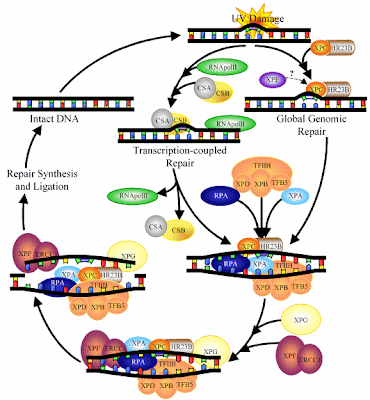Drug to Treat Accelerated Aging in Phase I Trial
 Prodarsan is a combination of small protein molecules devised by Pharming NV[PHGUF.PK] for treatment of premature aging including Cockayne's Syndrome.
Prodarsan is a combination of small protein molecules devised by Pharming NV[PHGUF.PK] for treatment of premature aging including Cockayne's Syndrome.Leiden, The Netherlands, April 23, 2008. Biotech company Pharming Group NV (Pharming) (NYSE Euronext: PHARM) announced today that its wholly owned subsidiary DNage has started a Phase I clinical study to evaluate the pharmacokinetics and tolerability of Prodarsan(R) in humans.Prodarsan's proposed mechanism of action is via the DNA repair mechanism of the cell.
Premature ageing, the primary target of Prodarsan(R), is a group of rare genetic diseases which manifests itself in several forms that are genetically and clinically similar although not identical. Dependent on the specific form of the disease, patients have a strongly reduced life expectancy and exhibit many ageing-related diseases early on in their lives. There is currently no effective therapy available for these patients.
Pharming has demonstrated that Prodarsan(R) as an oral, liquid formulation has significant effects in animal models for Cockayne Syndrome (CS). CS is one of the more common forms of premature ageing and is characterized, amongst others, by growth failure, mental retardation, eye abnormalities and a reduced life expectancy. The positive effects of Prodarsan(R) in preclinical testing on life expectancy in general and more specifically on the eye abnormalities are promising for further development of the product and its testing in humans.
The Phase I trial that is now being conducted consists of a combined single and multiple dose escalating clinical study in healthy volunteers. By studying the pharmacokinetics and tolerability of Prodarsan(R) and the effects of food intake on the absorption and elimination of the product, an oral dosing scheme will be determined that targets the pharmacological effective concentration range effectively. It is expected that following a successful completion of this trial the first clinical studies in patients will start later in 2008. Source
CKN1 is caused by a defect in the Cockayne syndrome type A gene (CSA or ERCC8) located on chromosome 5. Affected persons inherit 2 mutant genes, one from each parent. Cells carrying ERCC8 mutations are hypersensitive to UV light. They do not recover the ability to synthesize ribonucleic acid (RNA) after exposure to UV light. In addition, the cells cannot remove and degrade deoxyribonucleic acid (DNA) lesions from strands that have active transcription.We can hope that experience in augmenting DNA repair in the tragic accelerated aging syndromes may be helpful in devising strategies to augment DNA repair in helping to delay normal aging.
Mutations in the DNA excision repair gene ERCC6 located on band 10q11 cause CS type 2 (MIM number 133540; CSB). This gene encodes helicase, a protein that is presumed to have DNA unwinding function. Mutations include a deletion of exon 4, an amino acid substitution at the 106th glutamine to proline (Q106P) in the WD-40 repeat motif of the CSA protein, and large deletion in the upstream region, including exon 1 of the CSA gene. The Q106P mutation could alter the propeller structure of the CSA protein, which is important for the formation of the CSA protein complex. Additionally, a missense mutation (A205P) and a nonsense (E13X) mutation have been identified, as well as a new common single nucleotide polymorphism in CKN1. No genotype-phenotype correlation exists. _EMedicine
Previously published in Al Fin Longevity
Labels: DNA repair, longevity
3 Comments:
This medication is precisely in line with Aubrey deGray's statements regarding SENS. It is mitigating the damage to genetic replication that occurs over time.
This is a genuine anti-agapic, in other words, from what you quoted.
Yes, I agree. It addresses one of the seven main approaches to anti-age engineering that de Grey focuses on.
As soon as I know more about the actual mechanisms of the drug I'll try to post a better explanation of how it works.
To back up and correct myself, de Grey thinks (Chap 12 Ending Aging) that we won't be able to fix nuclear DNA damage as it occurs because there are too many genes to keep track of. He prefers to let the cells age, then deal with them when they stop functioning normally, or present a danger (eg cancer etc).
The approach described in this article seems geared to dealing with the specific types of altered genes that cause Cockayne's Syndrome, and related accelerated aging syndromes due to faulty DNA repair mechanisms.
I am guessing that the drug undergoing early trials may be a combination of gene product proteins meant to replace the product of the normal gene that is defective in Cockayne's etc., or otherwise serve to augment the DNA repair mechanism that is defective in these diseases.
If the proteins in this or a similar drug work well enough to safely augment DNA repair mechanisms in general, they may actually lead to a nuclear DNA repair method that would work in parallel with de Grey's 7 approaches.
Again, I will give more details as I am able to dig them out.
Post a Comment
“During times of universal deceit, telling the truth becomes a revolutionary act” _George Orwell
<< Home